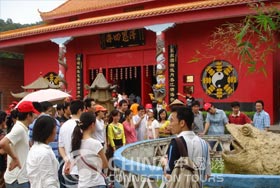
 A-Ma Temple already existed before the city of Macao came into being. Macau's name is dedicated to the god A-Ma (Mother and Queen of the Sea) whom Macau is named after and this temple dedicated to the seafarers' goddess dates from the early 16th century. Legend has it that A-Ma was a poor girl travelling to China, but was turned away by wealthy junk owners. Finally, a fisherman took her to Macau, withstanding a storm that sunk all the other junks. Later, she reappeared to the fisherman as a goddess and so he built here this temple. Situated on the southern tip of Macau, the temple has a friendly, relaxing environment.
A-Ma Temple already existed before the city of Macao came into being. Macau's name is dedicated to the god A-Ma (Mother and Queen of the Sea) whom Macau is named after and this temple dedicated to the seafarers' goddess dates from the early 16th century. Legend has it that A-Ma was a poor girl travelling to China, but was turned away by wealthy junk owners. Finally, a fisherman took her to Macau, withstanding a storm that sunk all the other junks. Later, she reappeared to the fisherman as a goddess and so he built here this temple. Situated on the southern tip of Macau, the temple has a friendly, relaxing environment.
A-Ma Temple is situated halfway up the western slope of Barra Hill. It consists of the Gate Pavilion, the Memorial Arch, the Prayer Hall, the Hall of Benevolence, the Hall of Guanyin, and Zhengjiao Chanlin (a Buddhist pavilion), each forming a small part of the well-ordered complex which sits in perfect harmony with the natural environment. The variety of pavilions dedicated to the worship of different deities in a single complex make A-Ma Temple an exemplary representation of Chinese culture inspired by Confucianism, Taoism, Buddhism and multiple folk beliefs.
Parts of the temple are more than 600 years old and were built before the arrival of the Portuguese. Today, the temple complex consists of Ming dynasty shrines, prayer halls, pavilions and gardens creeping up the hillside. It is a fascinating and atmospheric working temple and is particularly interesting and vibrant in April and May during the festival of A-Ma, when this is a popular place of pilgrimage. It is busy too, at Chinese New Year when the sound of firecrackers is deafening.
 The pavilions of A-Ma Temple were built at different times, with its present scale acquired in 1828. The Hall of Benevolence is believed to be the earliest structure, dating back to 1488. The Prayer Hall or “The First Palace of the Holy Mountain” was built in 1605 and rebuilt in 1629; archaeological evidence of these dates was recovered on stone inscriptions at the pavilion. The Prayer Hall dedicated to Tian Hou (Goddess of Seafarers) is a granite structure featuring lattice windows and upturned roof ridges. Ceramic animal decorations sit on exaggerated upturned roof ridges, forming a very distinctive profile. The date of construction for the Hall of Guanyin is unknown, but an inscription on a timber plaque at the entrance gives the date of a restoration conducted in the year 1828. Zhengjiao Chanlin was restored in the same year, which has more refined architectural details and is more impressive in scale. It consists of a shrine dedicated to Tian Hou and a retreat area with roof fashioned in the yingshan style. The shrine is a four-beam structure housed within high gabled walls that were used to protect against the risk of fire. The front façade features a moon gate, elaborately trimmed in granite and is richly decorated with colourful wall sculptures as well as delicate ornaments under the eaves.
The pavilions of A-Ma Temple were built at different times, with its present scale acquired in 1828. The Hall of Benevolence is believed to be the earliest structure, dating back to 1488. The Prayer Hall or “The First Palace of the Holy Mountain” was built in 1605 and rebuilt in 1629; archaeological evidence of these dates was recovered on stone inscriptions at the pavilion. The Prayer Hall dedicated to Tian Hou (Goddess of Seafarers) is a granite structure featuring lattice windows and upturned roof ridges. Ceramic animal decorations sit on exaggerated upturned roof ridges, forming a very distinctive profile. The date of construction for the Hall of Guanyin is unknown, but an inscription on a timber plaque at the entrance gives the date of a restoration conducted in the year 1828. Zhengjiao Chanlin was restored in the same year, which has more refined architectural details and is more impressive in scale. It consists of a shrine dedicated to Tian Hou and a retreat area with roof fashioned in the yingshan style. The shrine is a four-beam structure housed within high gabled walls that were used to protect against the risk of fire. The front façade features a moon gate, elaborately trimmed in granite and is richly decorated with colourful wall sculptures as well as delicate ornaments under the eaves.

